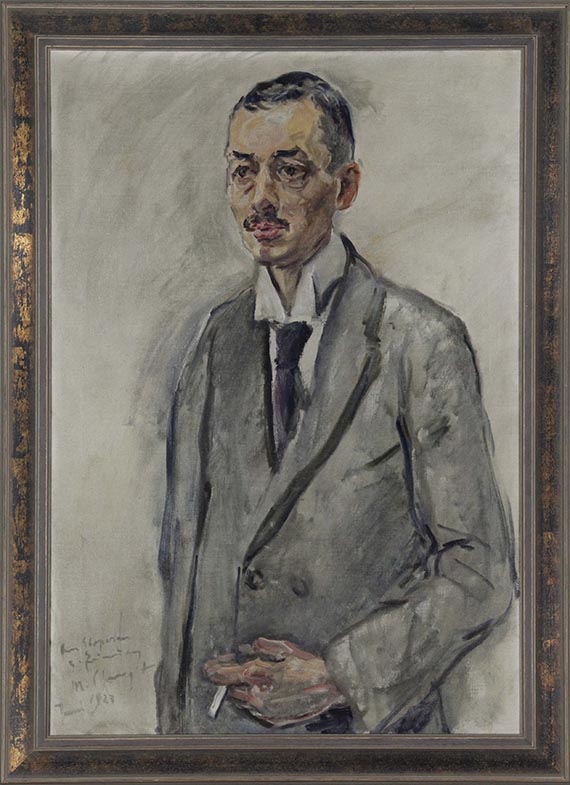313
Max Slevogt
Bildnis Theodor Stoperan, 1923.
Olio su tela
Stima:
€ 18,000 / $ 19,260 Risultato:
€ 15,240 / $ 16,306 ( commissione inclusa)
Bildnis Theodor Stoperan. 1923.
Oil on canvas.
Lower left signed and dated, and with the dedication "Herr Stoperan z. Erinnerung M. Slevogt Juni 1923". 89.5 x 62 cm (35.2 x 24.4 in).
[KT].
• Slevogt's portrait of Theodor Stoperan, just as Liebermann's from 1912, was long considered lost.
• The artist portrayed Paul Cassirer's general manager with a personal dedication.
• Stoperan was a key figure of the Berlin art scene at the beginning of the 20th century.
• Family-owned for decades, it is now offered on the auction market (source: artprice.com).
This work's authenticity was kindly confirmed orally by Mr Bernhard Geil. We are grateful fo his kind expert advice.
PROVENANCE:
Theodor Stoperan (1867-1938), Berlin (ever since family-owned).
EXHIBITION:
Kunstsalon Berliner Secession, Villa Thiede, Berlin, March 2008.
LITERATURE:
Hans-Jürgen Imiela, Max Slevogt, Karlsruhe 1968, p. 433, note 8 (there erroeously: "Hans Stoperan, 1923").
Jörg Niendorf, Mit Liebermann und Slevogt an den Wannsee, FAZ, February 29, 2008 (www.faz.net/aktuell/gesellschaft/secessionsmaler-sammlung-mit-liebermann-und-slevogt-an-den-wannsee-1512598.html).
Berliner Zeitung, March 1, 2008 (www.bz-berlin.de/archiv-artikel/wer-ist-der-liebe-mann-der-den-verschollenen-liebermann-heimholte).
Gabriela Walder, Ein neuer Liebermann am Wannsee, Berliner Morgenpost, March 2, 2008 (www.morgenpost.de/printarchiv/kultur/article102626055/Ein-neuer-Liebermann-am-Wannsee.html).
Oil on canvas.
Lower left signed and dated, and with the dedication "Herr Stoperan z. Erinnerung M. Slevogt Juni 1923". 89.5 x 62 cm (35.2 x 24.4 in).
[KT].
• Slevogt's portrait of Theodor Stoperan, just as Liebermann's from 1912, was long considered lost.
• The artist portrayed Paul Cassirer's general manager with a personal dedication.
• Stoperan was a key figure of the Berlin art scene at the beginning of the 20th century.
• Family-owned for decades, it is now offered on the auction market (source: artprice.com).
This work's authenticity was kindly confirmed orally by Mr Bernhard Geil. We are grateful fo his kind expert advice.
PROVENANCE:
Theodor Stoperan (1867-1938), Berlin (ever since family-owned).
EXHIBITION:
Kunstsalon Berliner Secession, Villa Thiede, Berlin, March 2008.
LITERATURE:
Hans-Jürgen Imiela, Max Slevogt, Karlsruhe 1968, p. 433, note 8 (there erroeously: "Hans Stoperan, 1923").
Jörg Niendorf, Mit Liebermann und Slevogt an den Wannsee, FAZ, February 29, 2008 (www.faz.net/aktuell/gesellschaft/secessionsmaler-sammlung-mit-liebermann-und-slevogt-an-den-wannsee-1512598.html).
Berliner Zeitung, March 1, 2008 (www.bz-berlin.de/archiv-artikel/wer-ist-der-liebe-mann-der-den-verschollenen-liebermann-heimholte).
Gabriela Walder, Ein neuer Liebermann am Wannsee, Berliner Morgenpost, March 2, 2008 (www.morgenpost.de/printarchiv/kultur/article102626055/Ein-neuer-Liebermann-am-Wannsee.html).
Theodor Stoperan belonged to the innermost circle of important figures with influence on the art scene in the metropolis of Berlin at the beginning of the 20th century. Born in Bremen, Stoperan, who a trained merchant, joined the Galerie Paul Cassirer, founded in 1898, probably around 1908. The art dealership, which was founded as an art salon with a sophisticated program and a publishing house, initially exhibited in three rooms at Bruno and Paul Cassirer's private apartment, would soon receive great attention. Max Liebermann was one of the first artists to establish a close relationships with the gallery, which would be of central importance for his future career. In his search for new exhibition spaces for the Berlin Secession, which he co-founded in 1892, he was able to win the Cassirers as managing directors of this company. This early alliance laid the foundation for the gallery's fruitful collaboration with avant-garde artists. In 1910, Theodor Stoperan was the manager of the Secession ‘s exhibition center on Kurfürstendamm, and Max Liebermann as 1st Chairman of the Secession, was in charge of the exhibition organized in collaboration with other members such as Max Slevogt, Lovis Corinth and Max Beckmann. For art history this year was particularly significant, because of the debate about the rejection of expressionist works by the jury, whereupon the "New Secession" was founded by artists around Max Pechstein. Criticism of the choice of artists and internal quarrels finally prompted Max Liebermann to resign from his post as president in November 1911, and Max Slevogt also left the group. Both had meanwhile established themselves as artists. Liebermann was appointed to the senate of the Academy of Arts, and Slevogt headed a master studio at the Academy of Arts in Berlin from 1917. Stoperan finally left Cassirer in 1920 and switched briefly to Galerie Karl Haberstock, whose rather conservative program of Old Masters may have interested him less. Alfred Flechtheim, who had moved to Berlin in 1921, put him in charge of his newly opened branch on Lützowufer 13 that year. The opening exhibition brought together the big names of the French avant-garde, including Braque, Derain, Picasso, de Vlaminck and Matisse. At Flechtheim's legendary exhibition openings and balls, Stoperan used to be a regular alongside actresses, the finance elite, diplomats, writers and celebrities. In January 1928, he entered into a business relationship with Galerie Fritz Zickel in Munich, whose Berlin branch, which he was in charge of, went by the name "Galerie Fritz Zickel Theodor Stoperan & Co.". It opened with works by German artists such as Corinth, Klein-Diepold, Leibl, Liebermann, Pechstein and Slevogt. On November 2/3, the Berlin auction house Paul Graupe auctioned a large share of Stoperan’s collection, including top-class works by Liebermann, Munch, Nolde, Pechstein and Renoir. Probably due to the global economic crisis of the late 1920s and due to the tense market and inflation, proceeds remained below expectation. However, the names listed in the catalog paint a picture of a courageous art lover who had become a supporter and friend of both Slevogt and Liebermann. [KT]
313
Max Slevogt
Bildnis Theodor Stoperan, 1923.
Olio su tela
Stima:
€ 18,000 / $ 19,260 Risultato:
€ 15,240 / $ 16,306 ( commissione inclusa)




 Lot 313
Lot 313 
